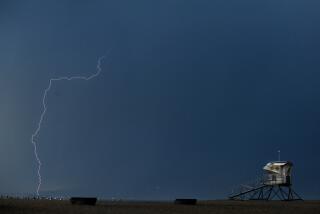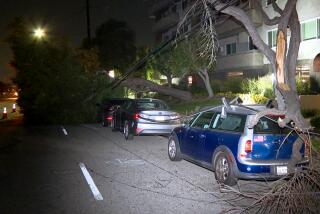Christo Folds Up Umbrella Art Project : Landscape: A death causes the project to close early amid high winds.
- Share via
LEBEC — Crews struggled in high winds Sunday to close Christo’s giant umbrellas after the artist ordered his bi-continental project to end four days early because of the death of an admirer who was crushed by an uprooted umbrella.
About 7,000 disappointed gawkers were met by rows of furled umbrellas, billowing like golden ghosts that disappeared into the fog shrouding the mountaintops. Hundreds of other umbrellas had been tattered or toppled by wind gusts before workers could crank them shut.
In Gorman, the California Highway Patrol closed two popular viewing sites because many sightseers were not heeding warnings to stay away from the umbrellas and were getting in the way of crews. Kern County sheriff’s deputies also arrested two people for trespassing on private property.
“It’s sad to see so many are broken. I think Christo will be heartbroken when he sees this,” said Cindy Olson, a homemaker from Westlake Village.
Despite extensive media coverage, a number of visitors had not heard about the Saturday accident in which the wind uprooted one of the 488-pound umbrellas, crushing Lori Keevil-Mathews, 34, an insurance agent from Camarillo, against a boulder. Others did not seem concerned.
“It was just an accident of nature. Why should it ruin everything for the rest of us?” said Bill Newberry, a retired construction worker from Bakersfield.
In a twist on the tragedy, Keevil-Mathews’ husband, Michael, said Sunday that his wife had a rare disease of the adrenal glands and was told she had about eight years to live. He declined to comment on whether he was contemplating a lawsuit, and the Christo press office would not release information about how much liability insurance was purchased for the project.
Christo officials, meanwhile, mourned Keevil-Mathews’ death and puzzled over what went wrong. Christo was in Japan, where he had been touring the Japanese portion of the exhibit. Colleagues said Christo, who ordered the Japanese umbrellas closed as well, would return to the Tejon Pass area this afternoon.
“It is just such a shame it had to end like this,” said Vince Davenport, director of field operations for the project.
On the rugged hills, small clumps of paid workers faced gale-force winds, biting cold and curious crowds Sunday as they rushed from site to site to close the umbrellas.
In contrast to the opening day’s euphoria among workers--many of them self-professed Christo groupies who took leaves from better-paying jobs--closing day was grim. They tallied each successful furling of an umbrella as if reciting body counts.
Each umbrella had to be hand-cranked and some workers were thrown from the cranks as winds rushed in under the umbrellas’ folds.
Crew leaders described the conditions as “dangerous” in calls to Christo headquarters on their two-way radios, and as night fell Sunday it became clear that they would not be able to close all 1,760 of the umbrellas.
Christo officials said they could not estimate how long it would take to complete the closure nor how many workers had shown up Sunday.
On steep hillsides above Gorman, actor Wade Mayer and sculptor Burt Payne III downed umbrellas by tugging on weighted ropes attached to the umbrella ribs. Dozens of spectators ignored the hazard and tried to climb the hills to get a closer look, and take pictures, of the vanishing artworks.
“These things can go at any time,” Payne yelled above the noisy flapping of golden fabric. Payne had wrapped his feet in bread bags and taped garbage bags to his legs to keep out cold and water.
Nearby, a field of 20 or 30 umbrellas lay smashed by the wind, their metal frames felled like matchsticks.
Anyone who has ever had an umbrella turn upside down during a windy rainstorm recognizes the basic flaw in their construction. Mindful of this natural proclivity to try to take flight, the Christo crew had tested their umbrellas in wind tunnels, said Augie Huber, the project’s general contractor.
In addition, umbrellas located along roadways and in strong wind areas were inspected every day and the rest were inspected every two days, Huber said.
Weather forecasts released on Friday from public and private weather services warned of an approaching storm, but they predicted winds no stronger than 35 m.p.h. But on Saturday afternoon, the forecasts were changed to include unseasonally strong winds of up to 60 m.p.h., said Steve Burback, a meteorologist with Weatherdata Inc., a private forecasting firm.
Weatherdata and the National Weather Service were unable to provide specific wind readings for Saturday and Sunday in the Tejon Pass because they do not have monitoring stations there.
Huber said the Christo group was aware of the area’s windy climate and had “years and years of data,” and he said they chose October for the umbrellas project because “it is the calmest month.”
Burback, however, said Sunday that historical data from nearby stations indicates otherwise. He said storms from the Gulf of Alaska, which can carry strong, cold winds, often begin reaching Southern California at the end of October.
“It was unusually strong for late October,” Burback said. “However, our records show peaks of between 38 and 46 m.p.h. for that time frame.”
Whether Christo representatives had access to that information was unclear Sunday. They subscribe to a private weather service, but they would not disclose which one.
Designs for the project were approved by a bevy of Los Angeles and Kern County officials, with specialties ranging from public works to planning to fire prevention.
Yet there was evidence from early in the project’s life that those tests and reviews were not sufficient to account for the erratic turns of nature. The day after the bi-continental exhibit opened, three umbrellas fell in Japan during a storm generated by an offshore typhoon.
That incident prompted project officials to close all of the blue Japanese umbrellas for several days. The California umbrellas also were closed on the night of Oct. 20 as a precaution when winds picked up, but they were reopened the next day.
Those who caught a last-minute peek at the exhibit Sunday morning said they hoped that the death and the potential for lawsuits would not hurt future Christo plans, such as wrapping the Reichstag, the former parliament building in Berlin, or erecting a series of gate-like structures in New York’s Central Park.
“I feel real bad for Christo and for the family of the woman who was killed,” said Diane Medina, 36, an escrow officer from Newhall who had toured the exhibit three other times and came to bid it farewell Sunday.
“But even though I’m sad, what happened doesn’t completely taint Christo and his work,” she said. “That would be like saying we shouldn’t have the Olympics because there once was a massacre.”
Times staff writers David Colker, Aaron Curtiss and Tracey Kaplan in Lebec and Tina Daunt in Ventura contributed to this story.
RELATED STORIES: A3
More to Read
Sign up for Essential California
The most important California stories and recommendations in your inbox every morning.
You may occasionally receive promotional content from the Los Angeles Times.










